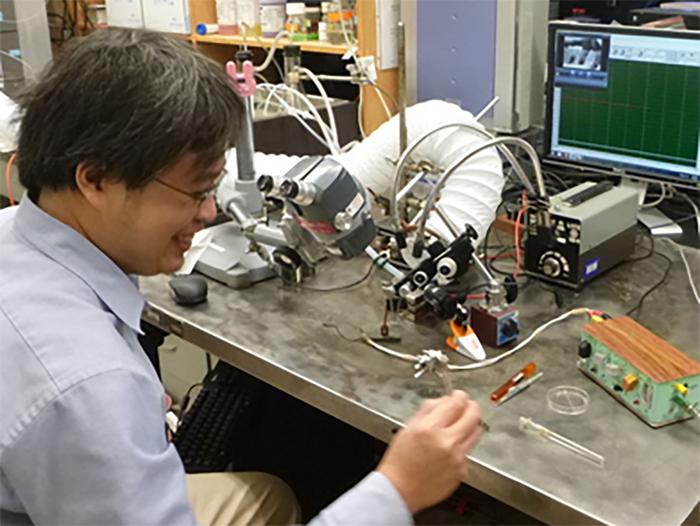It has long been known that exposure to pesticide sprays is harmful to honey bees. In a new study, researchers have uncovered the effect of such sprays on the sense of smell in bees, which could disrupt their social signals.

Credit: Ling-Hsiu Liao
It has long been known that exposure to pesticide sprays is harmful to honey bees. In a new study, researchers have uncovered the effect of such sprays on the sense of smell in bees, which could disrupt their social signals.
Honey bees live in dynamic communities and constantly communicate with each other using chemicals that serve as social cues. For example, nurse bees—that are responsible for taking care of larvae that ultimately become queens and worker bees—constantly monitor the larvae using in the dark using pheromones. The larvae emit brood pheromones to indicate that they need food. There are also alarm pheromones that workers produce to warn the other bees of danger. If these cues are dampened or not perceived properly, the colony may fail to thrive.
Since 2007, scientists have known that honey bees have been in trouble. One of the stressors that have raised concerns are insecticides, which affect honey bee health. Because these are usually used in combination with other chemicals, the resulting mixture can become unexpectedly toxic to bees.
“For many years, it was assumed that fungicides do not have an adverse impact on insects because they are designed for fungal targets,” said May Berenbaum (GEGC/IGOH), a professor of entomology. “Surprisingly, in addition to insecticides, fungicides also have an adverse effect on bees and combining the two can disrupt colony function.”
For more than a decade, reports originating from almond orchards, where two-thirds of the U.S. honey bees are transported every year when the flowers are in bloom, implicated pesticide spray mixtures. In particular, the problem lies in the use of supposedly inactive chemicals called adjuvants, which increases the “stickiness” of the insecticide so it stays on the plants.
Because adjuvants have long been considered to be biologically benign, they are not subject to the same level of safety testing as other insecticidal agents. “Recently, researchers have shown that adjuvants alone or when used in combination with fungicides and insecticides are toxic to bees,” Berenbaum said.
Nurse bees are especially vulnerable to these combinations. “The health of the queens is paramount,” Berenbaum said. “If healthy queens are not produced, the colony can suffer.”
To understand how combinations affect nurse bees, the researchers tested their effect on the olfactory system of honey bees using the adjuvant Dyne-Amic, the fungicide Tilt, and the insecticide Altacor.
The researchers divided bees into four groups of ten bees and for a week exposed them to either untreated commercial pollen or to pollen that had been treated with either Dyne-Amic, or Tilt and Altacor, or all three together. The bees were then anesthetized on ice and one antenna was carefully removed from each bee. The researchers then exposed the antenna to chemical mimics of brood and alarm pheromones and recorded the antenna’s response using a technique called electroantennography.
With this method, Ling-Hsiu Liao, a research scientist, and Wen-Yen Wu, a graduate student, in the Berenbaum lab, found that when nurse bees had consumed pollen contaminated by the three chemicals, their antennal responses to some brood pheromones and alarm pheromones were altered. Their finding suggests that these commonly-used pesticides can interfere with honey bee communication.
How these chemicals interact and influence the bees is still unclear. “There are many possible explanations for how consuming these chemicals can affect the sensory responses of bees,” Liao said. “The antenna detects and triggers the response to olfactory signals. In this study we did not look at what other changes are triggered, particularly changes in behavior.”
In addition to parsing out the underlying molecular pathways that are affected, the researchers are also interested in testing other mixtures of commonly used pesticides as well as looking at the response of bees in other populations. They hope that their work can help beekeepers rethink how they manage and protect their colonies.
The study “Effects of pesticide-adjuvant combinations used in almond orchards on olfactory responses to social signals in honey bees (Apis mellifera)” was published in Scientific Reports and can be found at https://doi.org/10.1038/s41598-023-41818-7. The work was supported by the Almond Board of California, the USDA-AFRI National Institute of Food and Agriculture, Ohio State University, and the University of Illinois Urbana-Champaign.
Journal
Scientific Reports
DOI
10.1038/s41598-023-41818-7
Method of Research
Experimental study
Subject of Research
Animals
Article Title
Effects of pesticide-adjuvant combinations used in almond orchards on olfactory responses to social signals in honey bees (Apis mellifera).
Article Publication Date
20-Sep-2023




